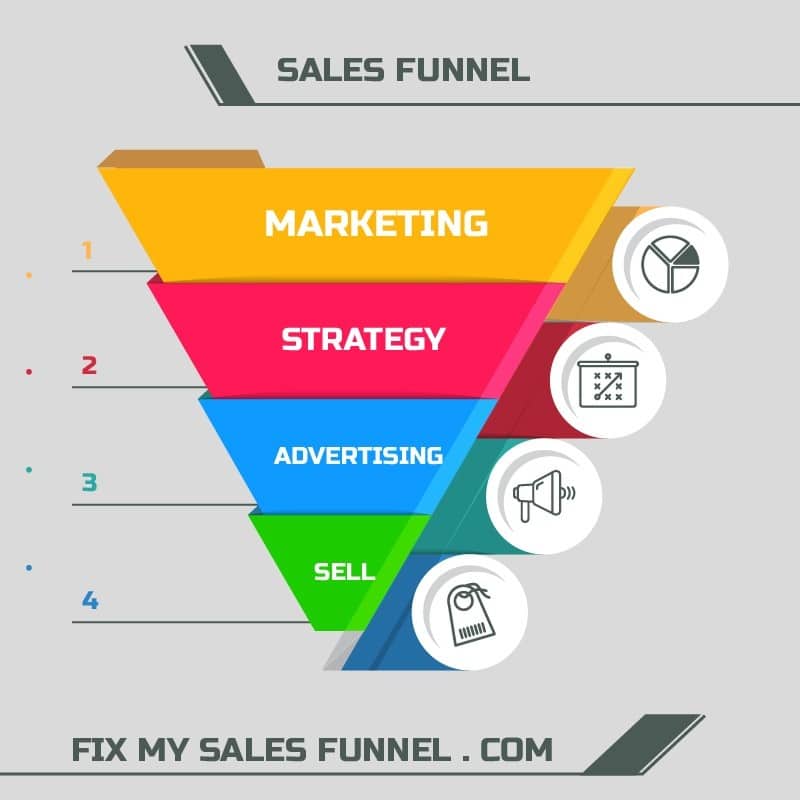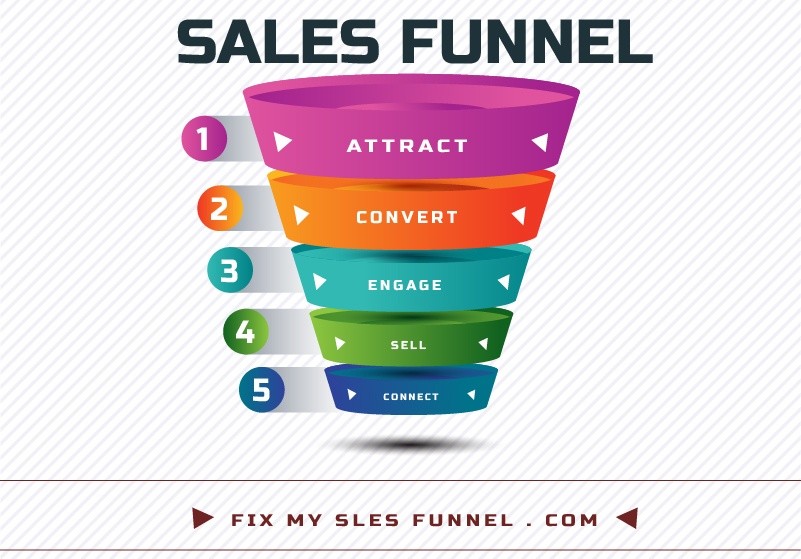B2B or B2C Sales Funnel?
- How it works? - how is it built? -Funnel Explained
Sometimes the sales department works at high speed, but this does not affect, because not every potential customer finalizes the transaction. It also happens that the marketing department sends leads to salespeople, but they are of very low quality. Sometimes the number of leads exceeds the expectations of sellers, and at the end, it turns out that only a small range of inquiries ends with a purchase. Therefore, build a sales funnel that will help you verify the real needs of customers and choose different activities that are most suitable for them at the moment.


sales funnel stages
Sales funnel: B2B or B2C?
The sales funnel has this feature that can be used on any channel. They were created with e-commerce in mind, as well as to support the activities of B2B traders. Their structure is practically no different, and various guides show funnels divided into smaller elements, usually four, sometimes five or six. The primary levels are:
attracting customers, building awareness - we are talking about all marketing and PR activities that are supposed to interest future customers initially. It is nothing but an attempt to appear in their consciousness;
building interest, acquiring leads - this is one big stage, which aims to convince these potential customers to get acquainted with the company's offer. An analysis of their behaviour allows them to be further moved to the lower part of the funnel, which aims to classify leads;
lead classification - one of the essential elements of the sales funnel. Well-recognized leads facilitate the work of sales representatives. It's easy. If marketers see that the lead is attractive, e.g. by giving it appropriate scoring, then they pass it directly to the sales department, where the transaction is often already closed;
sales and after-sales activities - at the very bottom of the funnel is the finalization of orders. Still, we should also include after-sales support and building relationships with the customer. So we can be sure that in the future he will come back to us because he will be satisfied with the service.
Each of these levels is a lot of activities and elements. It is worth optimizing all of them, because firstly - our costs will be lower. Secondly - we will spend less time finding hot leads, and thirdly - we will sell the product or service faster.
By dividing the sales process into individual stages, we can:
- tell traders and the marketing department what actions to take with the client at each stage;
- use the lead evaluation system and focus on the hottest ones;
- check the effectiveness of sales representatives at individual sales stages;
- find out where and at what stage we "lose" the most customers.
Sales funnel: How to attract customers? explained
We know - to reach a broader range of our offer, we need appropriate advertising and promotional activities. The message that we direct to recipients must be clear and accessible. If we make a promise, it must be kept, and otherwise in the future, the customer will not come back to us. To build awareness of the existence of our brand, we need the right tools to enable us to reach leads. The most important thing is that at this first stage, in the upper part of the funnel, also called ToFu (Top of the Funnel), do not take any sales actions in any way. Among other things, because we do not know what the expectations of our message recipients are.
Activities at this stage include:
Content marketing activities - according to research carried out by GetResponse, content marketing is one of the three most frequently used tools for promotional events. Among other things, because when creating content, we can focus on keywords that can affect the position of our site in search engines. We can search for phrases related to our industry with appropriate tools, which is very helpful when we write texts related to our product or service. To explain what it looks like, let's use an example.
Suppose we sell a B2B lead classification tool. It is a solution targeted at a specific group that may not even realize that it may support sales. That is why it is worth publishing on the company's blog and in the media texts related to this topic, case studies or guides on this type of solutions. In this way, for example, we will find people who will search for phrases related to lead scoring, lead assessment, the impact of scoring on sales, etc. Content marketing has the feature that it allows matching content to a narrow group of readers. The ranges are not that big then, but the materials reach those who should read them;
activities in social media - if our offer is directed to B2C, then we will usually want to reach users on Facebook, Twitter or Instagram. Content is also essential here. High-quality photos, new entries, engaging content. It all affects how we are perceived by readers. When we decide on B2B activities, it is worth focusing on business-oriented portals, e.g. LinkedIn.
Advertising on the Internet or in other media - of course, advertising on the Internet, including SEO activities, Google Adwords, is a mandatory element of every campaign. If we talk about other media, e.g. the press, then, of course, you can use this channel of reaching. Still, only if we are sure that the medium goes to the group of recipients, we are interested in and when we are convinced that we will get any return on investment from these activities.

tofu mofu bofu sales-funnel
We generate leads, i.e. we build interest
Let's assume that our advertising activities were directed to 10,000 customers. This is because we have an e-mail database. However, only 2000 people opened the e-mail, and only 500 of them reached the dedicated landing page. Of course, the given values are theoretical; we use them only to illustrate this stage. People who opened the e-mail and those who entered the site ceased to be anonymous to us. There was something in the sent creation that interested them. Maybe it was just the guide we prepared, or perhaps another part of the message that contained explicit CTA.
In this way, we will be able to reach these people much easier in the future. By creating relevant content and subsequent creations, we make it easy to understand that we know our work, and the solution we offer may be what the potential future client expects. The tools that will come to our aid include, but are not limited to, free pieces of training, trial versions, free reports and analyzes, as well as thought-out offer mailing.
We classify the obtained leads
Depending on the behaviour of people who somehow came into contact with our brand, we will be able to proceed to lead classification. At this stage, lead scoring comes to the aid, which quite easily allows you to assign point values to each of them, and thus create their groups. Thanks to this, you can decide what to do next with the given lead.
The most important for the sales department are the hot ones because they require an immediate response. Such people can already become our customers; all you need is a properly conducted conversation or negotiations. The remaining leads must be warmed up by subsequent actions or after several attempts; if they fail, they cease to be conquered. Such people usually stay in the databases they have signed up to. After some time we can try to reach them again with a new campaign reminding them about our product.
Sales funnel: Sales and after-sales activities explained
When the sales department receives a pool of suitably hot leads, it will be able to move on to the sales stage. However, this phase cannot end when invoices have been issued to customers. Our activities should include those associated with after-sales service, especially if the product or service is from the premium category. The relationship that was established when traders first came into contact with the lead must be maintained.
We are not talking here about intrusive calling every week with a new offer, but rather about thanking you for your purchase, assigning a dedicated consultant to the customer if he encounters problems, offering discounts for subsequent purchases, or contacting you when the product you have used up. For example, if we sell 1000 reams of paper to a customer and we know that he consumes them after 30 days, then it is worth contacting him with a new offer with an additional discount.
Sales funnel: Small steps called micro-conversions
Micro conversions are all activities that make the customer move from the top of the funnel to the bottom. However, they do not have to be related to the purchase itself. Micro conversions include, but are not limited to, subscribing to the newsletter, clicking on the link of interest to us, throwing the product to the basket in the e-store, or sending a query via the web form. According to the Nielsen Norman Group, "micro-conversions help measure the impact of changes and improvements affecting user-experience.
Often, the effect of small changes cannot be detected at the macro conversion level. " That is why it is worth analyzing each element of the funnel and checking how many leads are flowing to its further part, i.e. to BoFu (Bottom of the Funnel). If we assume that 10% of leads make a purchase and 90% do not reach the bottom of the funnel, then our task is to focus on this 90 % and using micro-conversions to analyze how many leads we lose and why.
Maybe the problem is the wrong contact form, the lack of relevant information on the site, too long waiting time for a connection with a consultant? Following the Disney example, each activity consists of micro-actions that can be improved. This also happened in his amusement parks. Thanks to this, Disneyland enjoy an 80% rate of returning customers to them.

